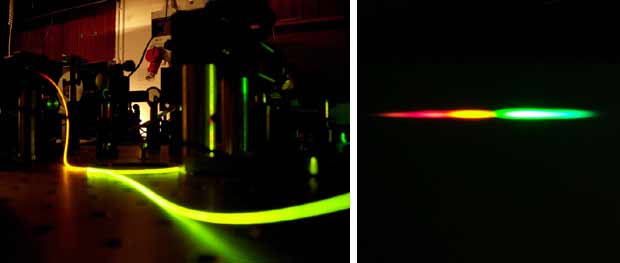Black Hole Effect Created in Lab

The mysterious properties of black holes can be recreated on a tabletop, scientists now reveal.
Solving mysteries concerning black holes could yield key clues toward a "theory of everything" that unites how we conceive of all the natural forces.
Black holes rank among the greatest enigmas of the universe. Scientists theorize black holes have gravitational pulls so powerful that nothing, including light, can escape after falling past a border known as the event horizon.
Direct experiments with black holes are unlikely, due at the very least to how far any are from Eearth, not to mention how difficult these warps in space and time would be to work with. Instead, researchers are searching for ways to create lab models of event horizons.
Now scientists have created an artificial event horizon on a tabletop using fiber optics.
The researchers started by firing a stream of intense, brief laser pulses inside an optical fiber. These pulses acted like a current of flowing light.
Such intense, brief pulses "make physical effects visible that would also occur for much longer and weaker pulses, but are hard to detect there," explained researcher Ulf Leonhardt, a theoretical physicist at the University of St. Andrews in Scotland. "High intensity and short pulses are needed for seeing subtle effects and discriminating them from noise."
At the same time, the researchers fired a continuous beam of infrared light down the optical fiber. This beam created waves that got overtaken by the laser flow, resembling how light waves are overcome by the gravitational pull just past an event horizon.
"The most surprising aspect for me is how simple it actually is to create artificial event horizons," Leonhardt told LiveScience. He and his colleagues detailed their findings in the March 7 issue of the journal Science.
Scientists had proposed other systems to mimic aspects of black holes. All those, however, needed moving parts — specifically, very fragile, ultra-cold blobs of matter — and none of them have yet successfully displayed phenomena resembling event horizons.
The artificial event horizons Leonhardt and his colleagues have devised could help researchers explore bizarre aspects of black holes, such as radiation they are supposed to emit. Black holes are not entirely black — instead, physicist Stephen Hawking discovered that all black holes should evaporate at least a bit, leaking energy dubbed "Hawking radiation."
Scientists have not yet seen this mysterious energy — Hawking radiation from normal black holes is completely obscured by the cosmic microwave background, radiation left over from the Big Bang that pervades the entire universe. However, Leonhardt suggests that with their new lab model, "we can create artificial event horizons that would generate enough Hawking radiation to be detectable."
A greater understanding of Hawking radiation could help unite our currently disparate theories of physics into one "theory of everything." that could conceive of all the natural forces.
So far scientists have not successfully united the field of general relativity, which explains how matter and energy behaves at large scales and predicts the existence of black holes, with that of quantum mechanics, which helps explain how matter and energy behaveact at the atomic level (and at smaller levels)below and predicts the existence of Hawking radiation.
A better understanding of Hawking radiation could help bridge general relativity with quantum mechanics to understand how these "worlds are connected," Leonhardt explained.
- VIDEO:Black Hole Diving
- VOTE NOW: The StrangestThings in Space
- VIDEO:Black Holes: Warping Time & Space
Get the Space.com Newsletter
Breaking space news, the latest updates on rocket launches, skywatching events and more!
Join our Space Forums to keep talking space on the latest missions, night sky and more! And if you have a news tip, correction or comment, let us know at: community@space.com.

Charles Q. Choi is a contributing writer for Space.com and Live Science. He covers all things human origins and astronomy as well as physics, animals and general science topics. Charles has a Master of Arts degree from the University of Missouri-Columbia, School of Journalism and a Bachelor of Arts degree from the University of South Florida. Charles has visited every continent on Earth, drinking rancid yak butter tea in Lhasa, snorkeling with sea lions in the Galapagos and even climbing an iceberg in Antarctica. Visit him at http://www.sciwriter.us









